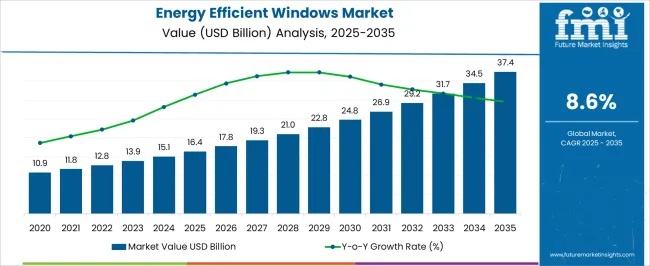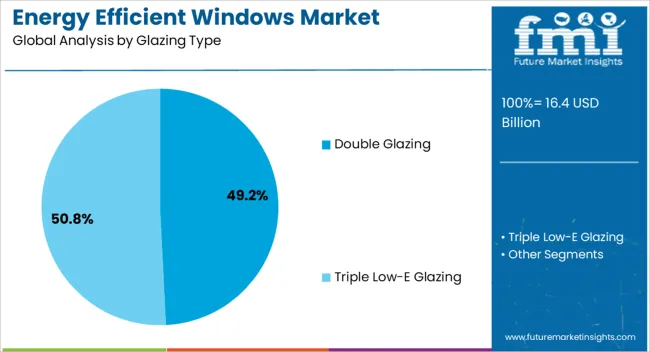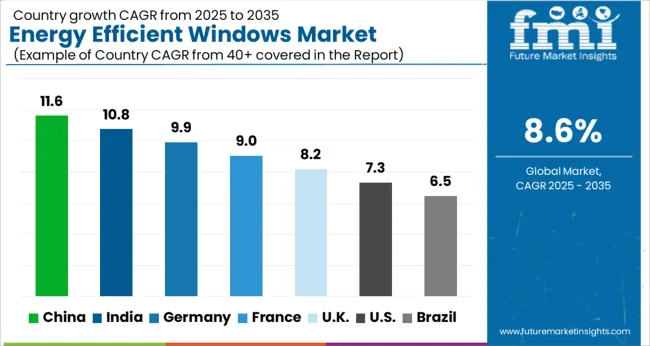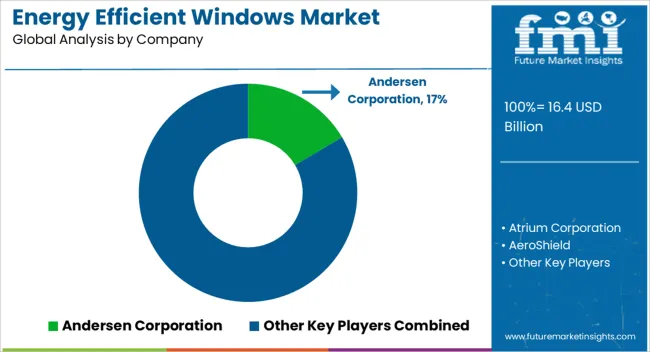The Energy Efficient Windows Market is estimated to be valued at USD 16.4 billion in 2025 and is projected to reach USD 37.4 billion by 2035, registering a compound annual growth rate (CAGR) of 8.6% over the forecast period. The market exhibits a clear maturity curve and adoption lifecycle, beginning with an early adoption phase characterized by steady but moderate growth prior to 2025, when awareness around energy conservation, regulatory incentives, and building efficiency programs started influencing uptake.
During this phase, premium glazing technologies and advanced insulation solutions gained traction primarily among environmentally conscious consumers and commercial developers. From 2025 to 2030, the market enters a scaling phase, where consistent double-digit growth is observed due to increasing mandates for energy-efficient construction and widespread availability of cost-effective window solutions.
Year-on-year value increments, rising from USD 16.4 billion to approximately USD 24.8 billion over this period, indicate accelerated adoption across residential, commercial, and institutional segments. Advancements in low-emissivity coatings, triple glazing, and smart window integration further fuel penetration, establishing the sector as a mainstream choice in building envelope design. Between 2030 and 2035, the market trends toward consolidation, with growth continuing but at a slightly moderated pace as most regions achieve near-saturation levels in adoption.
Technological differentiation, brand positioning, and integration with broader building automation systems become key competitive levers. By 2035, the market value will reach USD 37.4 billion, reflecting a mature and widely accepted technology within the global construction ecosystem.

| Metric | Value |
|---|---|
| Energy Efficient Windows Market Estimated Value in (2025 E) | USD 16.4 billion |
| Energy Efficient Windows Market Forecast Value in (2035 F) | USD 37.4 billion |
| Forecast CAGR (2025 to 2035) | 8.6% |
The energy efficient windows market is expanding steadily due to increased focus on reducing energy consumption in residential and commercial buildings. Government policies promoting green construction and energy conservation have encouraged the adoption of high-performance window solutions.
Advances in manufacturing and material science have enhanced window durability and thermal insulation properties, leading to wider consumer acceptance. Growing awareness about reducing heating and cooling costs combined with rising environmental concerns has driven demand.
The market is also benefiting from the trend of renovating older buildings with energy efficient products to meet modern standards. Future growth is expected to be propelled by incentives for energy-saving home improvements and innovations in smart window technologies. Segmental growth is anticipated to be led by double glazing as the preferred glazing type, replacement as the key adoption segment, and installations with more than 6 to 10 windows as the dominant category.
The energy-efficient windows market is segmented by glazing type, adoption rate, number of windows, application, and geographic region. By glazing type, the energy-efficient windows market is divided into double-glazing and triple low-E glazing. In terms of adoption, the energy-efficient windows market is classified into Replacement and Insulation. Based on the number of windows, the energy-efficient windows market is segmented into more than 6 to 10 units, up to 6 units, and more than 10 units. By application, the energy efficient windows market is segmented into Residential and Commercial. Regionally, the energy efficient windows industry is classified into North America, Latin America, Western Europe, Eastern Europe, Balkan & Baltic Countries, Russia & Belarus, Central Asia, East Asia, South Asia & Pacific, and the Middle East & Africa.

The double glazing segment is projected to hold 49.2% of the energy efficient windows market revenue in 2025, establishing its leadership in glazing types. This growth is driven by the superior insulation properties of double glazed windows, which reduce heat transfer and enhance indoor comfort.
Homeowners and builders have favored double glazing due to its ability to lower energy bills by minimizing heat loss during winter and heat gain during summer. Additionally, improvements in gas fills and low-emissivity coatings have enhanced performance without significantly increasing costs.
Double glazing also provides noise reduction and improved security, increasing its appeal. As building codes and energy standards become more stringent, the double glazing segment is expected to maintain its dominant position.

The replacement segment is anticipated to account for 53.7% of the market revenue in 2025, making it the leading adoption category. Growth in this segment has been fueled by the need to upgrade existing windows in aging buildings to more energy efficient options.
Property owners are increasingly opting for window replacements to improve energy efficiency, reduce maintenance, and enhance aesthetic appeal. Replacement projects benefit from government incentives and rebate programs aimed at promoting energy conservation.
Additionally, rising awareness about the benefits of energy efficient windows has encouraged homeowners to invest in upgrades. As a result, replacement demand is expected to remain strong, driven by residential renovation trends and sustainability goals.

The segment representing installations of more than 6 to 10 window units is projected to hold 41.8% of the market revenue in 2025, marking it as the dominant category by number of windows. This segment’s growth is driven by mid-sized residential and commercial building projects where multiple window replacements or new installations occur simultaneously.
Builders and homeowners seeking to achieve uniform energy performance across properties prefer to replace several windows at once. Bulk purchasing in this segment often results in cost advantages and streamlined installation processes.
The growing trend of upgrading whole-house window systems for energy efficiency has also contributed to segment growth. As building renovations and new constructions continue to prioritize energy conservation, the segment with 6 to 10 units is expected to maintain its market leadership.
The energy efficient windows industry has been expanding due to increasing demand for reducing residential and commercial energy consumption while improving indoor comfort. These windows have been widely utilized to minimize heat transfer, lower utility costs, and enhance building insulation. Market growth has been supported by advancements in double- and triple-glazing, low-emissivity coatings, and insulated frame materials. Rising awareness of energy conservation, government building codes, and the push for greener construction have further strengthened the adoption of energy efficient windows globally.
The growing need to reduce energy consumption in buildings has been a key driver of the energy efficient windows market. High-performance windows have been installed in residential and commercial structures to minimize heat loss in winters and reduce heat gain in summers, lowering dependency on heating, ventilation, and air conditioning systems. Advanced glazing techniques, such as low-emissivity coatings, gas-filled cavities, and thermally broken frames, have improved thermal insulation while maintaining natural light. The adoption of energy-efficient building designs and retrofitting older structures has further reinforced market growth. Incentives, tax rebates, and green building certifications have encouraged property developers and homeowners to prioritize energy-efficient window solutions. As energy costs rise and environmental awareness increases, energy efficient windows have become a critical component of sustainable building design globally.
Technological advancements have significantly improved the performance, durability, and aesthetic appeal of energy efficient windows. Modern double- and triple-glass configurations, argon or krypton gas infills, and advanced low-emissivity coatings have enhanced thermal insulation and reduced heat transfer. Smart windows with dynamic tinting, automated shading, and integrated sensors have allowed improved control over daylight and indoor temperature. Innovations in frame materials, including uPVC, fiberglass, and composite designs, have enhanced strength, weather resistance, and longevity. Energy modeling software and computer-aided design tools have optimized window selection based on orientation, climate, and building layout. These innovations have made energy efficient windows more attractive to developers, architects, and homeowners seeking cost savings, comfort, and compliance with energy codes.
Government regulations and environmental standards have played a crucial role in driving the adoption of energy efficient windows. Building codes in many countries now require minimum thermal performance for new construction, influencing material selection and window design. Energy labeling programs, such as ENERGY STAR certifications, have allowed consumers to compare thermal performance and make informed choices. Policies promoting reduced greenhouse gas emissions and sustainable construction practices have further reinforced market growth. Incentives, rebates, and grants for retrofitting existing buildings have accelerated adoption, particularly in urban areas. Regulatory frameworks combined with rising environmental awareness have ensured that energy efficient windows remain a critical component of energy conservation strategies in residential and commercial sectors globally.
The increasing focus on smart homes, green buildings, and sustainable architecture has created significant opportunities for the energy efficient windows market. Integration with automated shading systems, building management platforms, and energy monitoring solutions has enhanced their functionality. Demand for low-carbon and environmentally friendly materials, combined with modern aesthetics, has encouraged innovative window designs. Rising construction of LEED-certified and energy-efficient buildings has created a growing requirement for high-performance glazing and thermally insulated frames. As energy conservation and sustainability become central to urban planning and residential design, manufacturers are expected to develop advanced, customizable solutions that combine energy efficiency with durability and design flexibility. These opportunities are driving long-term growth in the global energy efficient windows market.

The market is projected to grow at a CAGR of 8.6% from 2025 to 2035, driven by rising demand for thermal insulation, energy savings, and environmentally friendly building materials. China leads with an 11.6% CAGR, supported by large-scale construction projects and green building initiatives. India follows at 10.8%, with increasing adoption in residential and commercial buildings focusing on energy efficiency. Germany, at 9.9%, benefits from government regulations and incentives promoting low-energy buildings. The UK, growing at 8.2%, emphasizes retrofitting older structures with advanced glazing solutions, while the USA, at 7.3%, sees steady demand fueled by energy codes and sustainable architecture trends. This report includes insights on 40+ countries; the top markets are shown here for reference.
The demand for energy efficient windows in China is projected to expand at a CAGR of 11.6% from 2025 to 2035, fueled by growing adoption in commercial and residential construction projects. Government initiatives promoting thermal insulation and energy conservation are driving the replacement of traditional windows. Manufacturers such as Saint-Gobain and China Glass Holdings are introducing advanced coatings and double-glazed solutions to reduce heat transfer and enhance energy efficiency. Integration of smart window technologies in high-rise developments is further increasing market penetration.
The energy efficient windows industry in India is expected to grow at a CAGR of 10.8% over 2025 to 2035, driven by rising awareness of energy conservation and government-led incentives. Urban housing projects are increasingly specifying low-emissivity glass and double-glazing solutions to reduce thermal loss. Manufacturers are leveraging cost-effective coating technologies to penetrate tier 2 and tier 3 cities. Commercial complexes in metro areas are adopting advanced insulating solutions to comply with building energy codes. Regional suppliers such as Fenesta and Jindal Glass are expanding production facilities to meet the growing demand for energy-efficient building envelopes, while partnerships with international technology providers enhance product offerings.

Sales of energy efficient windows in Germany are projected to expand at a CAGR of 9.9% between 2025 and 2035, supported by stringent European energy regulations. Retrofit projects in residential and office buildings are driving adoption of triple-glazed and thermally insulated windows. Leading manufacturers such as Schüco and Internorm are focusing on innovative frame materials and smart automation for shading and ventilation control. Public and private construction projects emphasize sustainable energy reduction measures, while government funding schemes for energy-saving renovations are boosting market growth.
The United Kingdom energy efficient windows market is expected to rise at a CAGR of 8.2% during 2025 to 2035, driven by adoption in commercial and residential sectors. Retrofitting programs and eco-building certifications are influencing demand for low-emissivity and double-glass solutions. Local manufacturers such as Anglian Windows and Everest are introducing high-performance frames and glazing combinations to comply with energy efficiency standards. Municipal initiatives for public building upgrades are further supporting market expansion, while consumer preference shifts toward reduced energy bills accelerate adoption.

The United States energy efficient windows industry is forecast to grow at a CAGR of 7.3% from 2025 to 2035, supported by federal incentives and green building certifications. Demand is driven by new residential construction in climate-sensitive regions and commercial projects aiming to reduce energy consumption. Manufacturers including Andersen and Pella are introducing advanced low-emissivity coatings and integrated smart window solutions. State-level rebate programs and energy-efficient building codes further encourage adoption across both urban and suburban areas.

The market is driven by rising demand for thermal insulation, reduced energy costs, and enhanced building performance. Andersen Corporation has established a strong presence by offering high-performance, multi-pane window solutions with advanced frame technologies. Atrium Corporation and AeroShield focus on innovative glazing and sealing technologies to improve thermal efficiency while maintaining aesthetic appeal. Builders First Choice emphasizes customization and retrofit solutions, targeting both residential and commercial sectors. Jeld-Wen, Kolbe Windows, and Marvin Windows & Doors integrate energy-efficient coatings and insulated glass units, balancing durability with enhanced performance.
Milgard Manufacturing and Pella Corporation deliver windows designed to withstand varied climates, combining low-emissivity coatings with precision engineering. PGT Windows and Simonton Windows offer hurricane-resistant and high-performance thermal solutions for demanding environments. Soft-Lite Windows specializes in premium materials and design flexibility, while YKK AP leverages aluminum and composite technologies to improve energy retention.
Key market strategies include product launches of multi-pane and low-emissivity systems, research into advanced frame and glass technologies, and collaborations with builders to meet energy codes. Entry barriers include high manufacturing costs, technical expertise, and adherence to regional energy efficiency standards, making innovation, durability, and compliance crucial for sustained market growth. Manufacturers that combine thermal performance with design versatility maintain a competitive edge in this evolving sector.
| Item | Value |
|---|---|
| Quantitative Units | USD 16.4 Billion |
| Glazing Type | Double Glazing and Triple Low-E Glazing |
| Adoption | Replacement and Insulation |
| Number of Windows | >6 to 10 units, Up to 6 units, and >10 units |
| Application | Residential and Commercial |
| Regions Covered | North America, Europe, Asia-Pacific, Latin America, Middle East & Africa |
| Country Covered | United States, Canada, Germany, France, United Kingdom, China, Japan, India, Brazil, South Africa |
| Key Companies Profiled | Andersen Corporation, Atrium Corporation, AeroShield, Builders First Choice, Jeld-Wen, Kolbe Windows, Marvin Windows & Doors, Milgard Manufacturing, Pella Corporation, PGT Windows, Simonton Windows, Soft-Lite Windows, and YKK AP |
| Additional Attributes | Dollar sales by window type and end-use application, demand dynamics across residential, commercial, and institutional buildings, regional trends in adoption across North America, Europe, and Asia-Pacific, innovation in low-emissivity coatings, double and triple glazing, and smart window technologies, environmental impact of energy savings, reduced heating and cooling loads, and sustainable material sourcing, and emerging use cases in retrofitting existing structures, net-zero building projects, and integration with automated building energy management systems. |
The global energy efficient windows market is estimated to be valued at USD 16.4 billion in 2025.
The market size for the energy efficient windows market is projected to reach USD 37.4 billion by 2035.
The energy efficient windows market is expected to grow at a 8.6% CAGR between 2025 and 2035.
The key product types in energy efficient windows market are double glazing and triple low-e glazing.
In terms of adoption, replacement segment to command 53.7% share in the energy efficient windows market in 2025.






Our Research Products

The "Full Research Suite" delivers actionable market intel, deep dives on markets or technologies, so clients act faster, cut risk, and unlock growth.

The Leaderboard benchmarks and ranks top vendors, classifying them as Established Leaders, Leading Challengers, or Disruptors & Challengers.

Locates where complements amplify value and substitutes erode it, forecasting net impact by horizon

We deliver granular, decision-grade intel: market sizing, 5-year forecasts, pricing, adoption, usage, revenue, and operational KPIs—plus competitor tracking, regulation, and value chains—across 60 countries broadly.

Spot the shifts before they hit your P&L. We track inflection points, adoption curves, pricing moves, and ecosystem plays to show where demand is heading, why it is changing, and what to do next across high-growth markets and disruptive tech

Real-time reads of user behavior. We track shifting priorities, perceptions of today’s and next-gen services, and provider experience, then pace how fast tech moves from trial to adoption, blending buyer, consumer, and channel inputs with social signals (#WhySwitch, #UX).

Partner with our analyst team to build a custom report designed around your business priorities. From analysing market trends to assessing competitors or crafting bespoke datasets, we tailor insights to your needs.
Supplier Intelligence
Discovery & Profiling
Capacity & Footprint
Performance & Risk
Compliance & Governance
Commercial Readiness
Who Supplies Whom
Scorecards & Shortlists
Playbooks & Docs
Category Intelligence
Definition & Scope
Demand & Use Cases
Cost Drivers
Market Structure
Supply Chain Map
Trade & Policy
Operating Norms
Deliverables
Buyer Intelligence
Account Basics
Spend & Scope
Procurement Model
Vendor Requirements
Terms & Policies
Entry Strategy
Pain Points & Triggers
Outputs
Pricing Analysis
Benchmarks
Trends
Should-Cost
Indexation
Landed Cost
Commercial Terms
Deliverables
Brand Analysis
Positioning & Value Prop
Share & Presence
Customer Evidence
Go-to-Market
Digital & Reputation
Compliance & Trust
KPIs & Gaps
Outputs
Full Research Suite comprises of:
Market outlook & trends analysis
Interviews & case studies
Strategic recommendations
Vendor profiles & capabilities analysis
5-year forecasts
8 regions and 60+ country-level data splits
Market segment data splits
12 months of continuous data updates
DELIVERED AS:
PDF EXCEL ONLINE
Commercial Energy-Efficient Windows Market Size and Share Forecast Outlook 2025 to 2035
Residential Energy Efficient Windows Market Size and Share Forecast Outlook 2025 to 2035
Energy Efficient Window and Door Market Size and Share Forecast Outlook 2025 to 2035
Energy Efficient Motor Market Size and Share Forecast Outlook 2025 to 2035
Residential Energy-Efficient Technologies Market Size and Share Forecast Outlook 2025 to 2035
Energy-saving Constant Humidity Storage Cabinet Market Size and Share Forecast Outlook 2025 to 2035
Energy Gel Product Market Size and Share Forecast Outlook 2025 to 2035
Energy Dispersive X-ray Spectrometer Market Size and Share Forecast Outlook 2025 to 2035
Energy Gel Product Market Analysis - Size, Share, and Forecast Outlook 2025 to 2035
Energy Storage Sodium Ion Battery Market Size and Share Forecast Outlook 2025 to 2035
Energy Harvesting Market Growth - Trends & Forecast 2025 to 2035
Energy Supplement Market Analysis by Product Type, End-user and Distribution Channel through 2025 to 2035
Energy Ingredients Market Analysis by Product Type and Application Through 2035
Energy Efficiency Gamification Market Analysis by Type, Deployment, End User, and Region through 2035
Leading Providers & Market Share in Energy Gel Industry
Energy Intelligence Solution Market - Growth & Forecast 2025 to 2035
Energy & Power Quality Meters Market Growth - Trends & Forecast through 2034
Energy Drink Market Outlook – Growth, Demand & Forecast 2024 to 2034
Energy Recovery Ventilator Core Market Growth – Trends & Forecast 2024-2034
Energy Portfolio Management Market Report – Trends & Forecast 2023-2033

Thank you!
You will receive an email from our Business Development Manager. Please be sure to check your SPAM/JUNK folder too.
Chat With
MaRIA